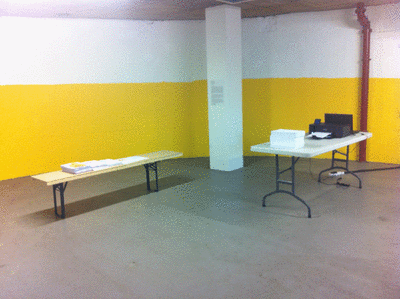SHAW, Becky (2014). Half-buried. [Show/Exhibition] [Show/Exhibition]
I first encountered the lithographic prints of David Roberts (1796-1864) in Cambridge, where a respected architect, Christoph Grillet showed his collection to me, as a way of introducing his experience of dementia. The images depict the pyramids, and other Middle- and Near-Eastern monuments and ruins as they appeared in the 1800s. Through the layering of. and removal of sand, the images record a process of exposing and concealing, reclaiming and losing civilisations. The images also give an insight into colonial and acquisitive patterns that have shaped several centuries of East-West relationships. That moment with Christoph, and one image in particular, The Pronaos of the Temple of Edfu, has haunted me for years, leaving me astounded at Grillet’s ability to use it to speak of his own organic quicksand.
I began to search for images of ‘The Pronaos’ using the contemporary technological quicksand of the internet. Every day I searched for this image new ones appeared and ones from the day before disappeared. Unlike the remarkable quality of the ‘original’ lithoprints, the web versions were a motley crew with poor colour balance: lemon yellows instead of golden sands, digital copyrights across them, badly framed, and taken in bedrooms or with flash glare. Half-Buried takes the cache for one day and prints it repeatedly in the gallery. The printer is put into over-ride so when ink runs low it continues to print, splitting the images, layered in time, into colour fields. The printer first exhausts the golden sand, then gives everything a pink cast, then finally bleaches the blue, before leaving hesitant lines and hollow caves of black before disappearing entirely. The splitting of colour reminds me of the visual halo we get when we move from dark room to bright sun- the change in conditions splitting light into its components.
During Monument the columns of prints accumulate, mirroring the sand layering steadily over ruins, or the wind exposing what is there already. The columns of prints begin to fill the gallery, as if they themselves are the sand, layering up the columns in the Undercroft space. The stacks of prints are an excess of remembering. Excess is important. Half-Buried employs repetition for the sake of it, like in a Beckett play; nothing starts and nothing ends, there is no final product. On one hand Half-Buried is romantic, nostalgic, and even kitsch, and on the other hand cold and critical, accommodating the insignificance of memory. In ‘Ghosts of my Life’(2014), Mark Fisher says, ‘In conditions of digital recall, loss is itself lost’
Downloads
Downloads per month over past year
Actions (login required)
 |
View Item |


 Tools
Tools Tools
Tools![[thumbnail of Half-Buried]](https://shura.shu.ac.uk/10304/1.hassmallThumbnailVersion/IMG_3235.jpg)

![[thumbnail of Half-Buried]](https://shura.shu.ac.uk/10304/2.hassmallThumbnailVersion/IMG_3259.jpg)

![[thumbnail of Half-Buried]](https://shura.shu.ac.uk/10304/3.hassmallThumbnailVersion/IMG_3236.jpg)

